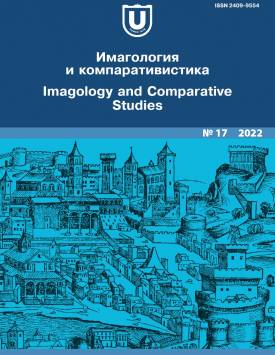On the Demarcation Between Attitude and Poetics (On the Example of Marriage by Nikolai Gogol)
Gogol’s works are very promising for the demarcation between the author’s attitude and the text’s idea and poetics that, usually, successively generate one another. However, Gogol’s attitude came from the archaic and normally could not become the text’s idea - including the motif of a marriage threat. In Evenings on a Farm Near Dikanka and Viy, this motif was part of the depicted folklore world and, thanks to it, was detached from the author. The motif spawns new ties between attitude, idea, and poetics in the comedy Marriage (1833, 1842). Here idea (satire on marriage-related estate swagger) is formally given, and so the motif of marriage threat (shown in Podkolesin’s indecision) goes beyond it and approves itself by contradiction. Kochkarev shows unconsciously in his praise of women the infinity of their bodies as the archaic background of Podkolesin’s attraction to and fear of marriage. This infinity comes from the Slavic belief that during menses the female body ties the people’s world with the underground world of the dead and the infinity of the Earth. The kinship between the woman and the animal, which is constantly voiced in the comedy, makes marriage shameful and transforms its diabolic symbolism into “devil’s laughter”. Placing the story of the failed marriage in the “non-Russian” Petersburg world (perceived by the Russian folk mind as a realized chimera), Gogol gives the hidden explanation of his fear of women personified in Podkolesin. At the very beginning of the comedy, the invasion of the real world by the chimeric one is manifested in “new mirrors” that show people their caricatures. The character’s obscene language is the sign of his high position in society (it is legitimated by the “sodomic” names); lies become an unconscious replacement of the truth, and the hyperbole approves the opposite. Zhevakin and Kochkarev reflect the succession of the archaic and laughter worlds in Marriage. The former represents the “alive deceased” and an old-Russian beggar; the latter a joker and a devil-matchmaker. The explicit and banal “idea” in Marriage is the starting point for the poetical expression of Gogol’s attitude. However, personifying it in the comical hero, who lives in a comical world, Gogol, like in Evenings on a Farm Near Dikanka and Viy (though in a different way), distanced himself from this attitude. Gogol’s late works show his own and hard-fought ideas. The archaic attitude was a fatal threat for them. The author declares no conflicts of interests.
Keywords
marriage threat,
attitude,
poetics,
idea,
laughter world,
puppet theatre,
character as childAuthors
| Ivanitskiy Alexander I. | Russian State University for the Humanities | meisster@mail.ru |
Всего: 1
References
Лотман Ю.М. Гоголь и соотнесение смеховой культуры со смешным и серьезным в русской национальной традиции // Материалы Всесоюзного симпозиума по вторичным моделирующим системам. Тарту, 1974. Вып. 1 (5). С. 70-75.
Манн Ю.В. Поэтика Гоголя. М. : Художественная литература, 1988. 416 с.
Виролайнен М.Н. Миргород Н.В. Гоголя. Проблемы стиля : дис.. канд. филол. наук. Л., 1980. 200 с.
Попович Т. Страх от брачного ложа - Пушкин и Гоголь // Болдинские чтения. Н. Новгород : НнГУ им. Н.И. Лобачевского, 2018. С. 145-154.
Гоголь Н.В. Полное собрание сочинений : в 14 т. М. ; Л. : Изд. АН СССР, 1937-1952.
Кабакова Г.И. Женщина // Славянские древности. М. : Международные отношения, 1995. Т. 2. С. 205-208.
Гончаров С.А. Творчество Гоголя в религиозно-мистическом контексте. СПб. : Изд. РГПУ им. А.И. Герцена, 1997. 340 с.
Слонимский А.Л. История создания «Женитьбы» Гоголя // Русские классики и театр. М. ; Л. : Искусство, 1947. С. 307-334.
Манн Ю.В. Грани комедийного мира («Женитьба» в чтении и на сцене) // Манн Ю.В. Творчество Гоголя. Смысл и форма. СПб. : Изд. СПбГУ, 2007. С. 518616.
Иваницкий А.И. «Господин де Пурсоньяк» Мольера и «Женитьба» Гоголя // Третьи Гоголевские чтения. Гоголь и театр. Сборник докладов. М. : Книжный дом «Университет», 2004. С. 101-107.
Виноградская Н.Л. Структура диалога в драматургии Н.В. Гоголя (комедия «Женитьба») : автореф. дис.. канд. филол. наук. М., 2006. 28 с.
Манн Ю.В. Драматургия Гоголя // История русской драматургии. XVII -первая половина XIX века. Л. : Наука, 1982. С. 426-474.
Воропаев В.А. Николай Гоголь: Опыт духовной биографии. М. : Паломник, 2008. 318 с.
Колюжный Е. Славянские боги и ритуалы. М. : РИПОЛ, 2007. 382 с.
Лихачев Д.С. Смех как мировоззрение // Лихачев Д.С., Панченко А.М. Смеховой мир Древней Руси. Л. : Наука, 1976. С. 7-90.
Панченко А.М. Русская культура в период петровских реформ // Из истории русской культуры. Т. 3 (XVII - начало XVIII в.). Ч. 1. М. : Школа «Языки русской культуры», 1996. С. 3-252.
Виролайнен М.Н. Брачные сюжеты в гоголевском Петербурге // Новый филологический вестник. 2019. № 3. С. 44-51.
Венедиктов Г.Л. Внелогическое начало в фольклорной поэтике // Русский фольклор. Л. : Наука, 1974. Т. 14. С. 219-237.
Козубовская Г.П. Деформация тела: мотив сломанных ног («Женитьба» Н.В. Гоголя) // Универсалии русской литературы : сборник статей. Воронеж : ВГУ, 2011. Вып. 3. С. 282-294.
Гольденберг А.Х. Архетипы в поэтике Н.В. Гоголя. М. : ФЛИНТА; Наука, 2012. 232 с.
Дмитриева Е.Е. «Пожив в такой тесной связи с ведьмами и колдунами..» (Об особенностях гоголевского фольклоризма: «Вечера на хуторе близ Диканьки») // Вторые Гоголевские чтения. Н. В. Гоголь и мировая культура. М. : Книжный дом «Университет», 2003. С. 138-152.
Мифы народов мира : в 2 т. М. : Советская энциклопедия, 1982.
Афанасьев А.Н. Поэтические воззрения славян на природу : в 3 т. (репринт издания 1865 г.). М. : Индрик, 1994.
Иваницкий А.И. Гоголь. Морфология земли и власти (К вопросу об историко-культурных истоках бессознательного). М. : Изд. РГГУ, 2000. 187 с.
Толстой Н.И. Близнецы // Славянские древности. М. : Международные отношения, 1995. Т. 1. С. 191-193.
Виноградова Л.Н., Левкиевская Е.Е. Окно // Славянские древности. М. : Международные отношения, 1995. Т. 3. С. 534-539.
Некрылова А., Савушкина Н. Русский фольклорный театр // Фольклорный театр. М. : Современник, 1988. С. 6-37.

